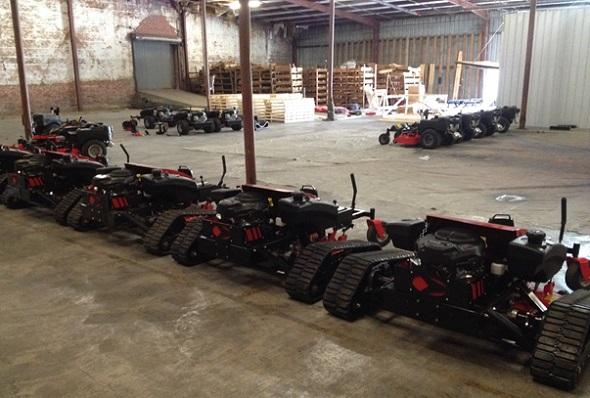
The idea of a remote-controlled lawnmower can be traced back to a man named John Wright who first attempted to create one himself in the 1990’s, using the unlikely combination of a push mower, a remote-controlled car, and a Barbie Power Wheels Jeep. Later, when he had access to Google and Youtube after the 2008 housing market crash, Wright launched a business, Summit Mowers, which required about four years of research and development work to get off the ground. By 2016, 30 mowers have been sold, and many more people are interested in checking out Wright’s remote mowers.
According to i.materialise, these epic monster lawnmowers “will mow anything that comes in their way and have no problem traversing extreme 40 to 50 degree slopes from site to site thanks to their exceptionally wide rubber tracks.” Government municipalities are a common customer for these mowers, as local governments are responsible for maintaining many steep hills.
“Our electronics have to be able to withstand dust, vibration and water or possible gas/oil spills. Fragile circuit boards and 25HP remote control mowers is not a safe idea. We use servos to operate rocker switches that energize relays for the mower’s electrical system all mounted on a 3D printed bracket. The servo arms have to be positioned perfectly over the rocker switch to operate efficiently. The days of making the brackets by hand and using shims to line up the components is long gone thanks to i.materialise.”
Wright also reports he’d like to 3D print some of the mowers’ metal parts one day, also.
The 3D printed bracket (see above) that carries the mounted relays for the mower’s electrical system proves to be an essential item for a mower that is fast gaining a reputation as a machine that runs better than traditional mowers. One example Wright gives of his mowers’ performance is taken from a city in Eastern Kentucky, where overpasses began to wash out and erode since traditional mowers can only mow up and down. Summit Mowers’ TRX-42-PRO mower is capable of mowing side to side, which prevents erosion, and it can even mow across washed out areas. The city purchased 3 units, which they’ve already put to use for over 1,000 hours of work. That is how well the mowers can work for large and complicated jobs.
We’ve heard of 3D printing enhancing many a traditional machine, and now we can add lawnmowers to this list with the example of Summit Mowers’ “epic monster mower” — which you can check out in the video below and at the company’s website. Discuss further in the Summer Mowers 3D Printed Relay Mount forum over at 3DPB.com.